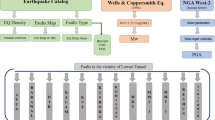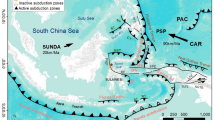Abstract
In this study, a method for simulating the response spectra of far-source long-period ground motion, based on the response spectrum ratio model, was proposed. The model was proposed for the response spectrum ratio between far-source and near-fault strong ground motions, in the period range of 0.1 to 10.0 s. It is a function of period, magnitude, and distance. This study was evaluated using strong-motion records acquired from Japanese strong-motion seismograph networks of the Nation Research Institute for Earth Science and Disaster Prevention, consisting of two horizontal components of 24 earthquake records, and including 5719 sets of strong-motion records, which were used for regression analysis. The response spectrum ratio model was applicable for the magnitude range of 6.0 to 9.0, and a distance of up to 800 km. Fitting curve analysis was performed to study the variation in the response spectrum ratio with the period. The validity of the response spectrum ratio model was examined using detailed residual analysis, and comparison with earthquake records, the Chinese Code for seismic design of buildings (GB50011-2010), the Eurocode, the long-period acceleration design response spectrum, and two simulations of the long-period of response spectrum models. Furthermore, simulation of the response spectra of far-source strong ground motion based on the response spectrum ratio model was performed. The results demonstrated that the response spectrum ratio model correlates the far-source response spectrum and near-field response spectrum. The simulation of the response spectra of far-source long-period ground motion using the response spectrum ratio model and near-field response spectrum was efficient.










Similar content being viewed by others

References
Aoi S, Kunugi T, Fujiwara H (2004) Strong-motion seismograph network operated by NIED: K-NET and KiK-net. J Jpn Assoc Earthq Eng 4(3):65–74. https://doi.org/10.5610/jaee.4.3_65
Aoi S, Honda R, Morikawa N, Sekiguchi H, Suzuki H, Hayakawa Y, Kunugi T, Fujiwara H (2008) Three-dimensional finite difference simulation of long-period ground motions for the 2003 Tokachi-oki, Japan, earthquake. J Geophys Res. https://doi.org/10.1029/2007JB005452
Boore DM (2003) Simulation of ground motion using the stochastic method. Pure Appl Geophys 160(3):635–676. https://doi.org/10.1007/PL00012553
Boore DM, Stewart JP, Seyhan E, Atkinson GM (2014) NGA-West2 equations for predicting PGA, PGV, and 5% damped PSA for shallow crustal earthquakes. Earthq Spectra 30(3):1057–1085. https://doi.org/10.1193/070113EQS184M
Çelebi M and Okawa I (2014) Drift issues of tall buildings during the march 11, 2011 M9.0 Tohoku Earthquake, Japan–implications. In: Proceedings of the 10th national conference in Earthquake engineering, Earthquake Engineering Research Institute, Anchorage, AK
EN 1998-1-2010 (2014), Eurocode 8: design of structures for earthquake, Berlin, European
Furumura T, Kennett BLN (2019) The significance of long-period ground motion at regional to teleseismic distances from the 610km deep Mw 8.3 Sea of Okhotsk Earthquake of 24 may 2013. J Geophys Res Solid Earth 124(8):9075–9094. https://doi.org/10.1029/2019JB018147
Furumura T, Maeda T, Oba A (2019) Early forecast of long-period ground motions via data assimilation of observed ground motions and wave propagation simulations. Geophys Res Lett 46(1):138–147. https://doi.org/10.1029/2018GL081163
GB 50011-2010 (2010) Code for seismic design of buildings, Beijing, China
Hu R, Xu Y, Zhao X (2018) Long-period ground motion simulation and its impact on seismic response of high-rise buildings. J Earthquake Eng 22:1285–1315. https://doi.org/10.1080/13632469.2017.1286617
Ikegami Y, Koketsu K, Kimura T, Miyake H (2008) Finite-element simulations of long-period ground motions: Japanese subduction-zone earthquakes and the 1906 San Francisco earthquake. J Seismolog 12:161–172. https://doi.org/10.1007/s10950-008-9091-5
Kalkan E, Kunnath SK (2006) Effects of fling step and forward directivity on seismic response of buildings. Earthq Spectra 22(2):367–390. https://doi.org/10.1193/1.2192560
Kataoka S, Matsumoto S, Kusakabe T, Toyama N (2008) Attenuation relationships and amplification map for ground motion in rather-long period range. Doboku Gakkai Ronbunshuu A 64:721–738. https://doi.org/10.2208/jsceja.64.721
Kiser E, Kehoe H (2021) The hazard of coseismic gaps: the 2021 Fukushima earthquake. Geophys J Int 227(1):54–57. https://doi.org/10.1093/gji/ggab208
Koketsu K, Miyake H (2008) A seismological overview of long-period ground motion. J Seismolog 12(2):133–143. https://doi.org/10.1007/s10950-007-9080-0
Koketsu K, Hatavama K, Furumura T, Ikegami Y, Akiyama S (2005) Damaging long-period ground motions from the 2003 Mw8.3 Tokachi-oki, Japan Earthquake. Seismol Res Lett 76(1):67–73. https://doi.org/10.1785/gssrl.76.1.67
Laske G, Masters G, Ma Z et al (2013) Update on CRUST1.0:a 1-degree global model of Earth’s crust. Geophysical research abstracts. EGU General Assembly Conference Abstracts, Vienna, Austria
Mavroeidis GP, Papageorgiou AS (2003) A mathematical representation of near-fault ground motions. Bull Seismol Soc Am 93(3):1099–1131. https://doi.org/10.1785/0120020100
Naeim F (1989) The seismic design handbook. Springer, Boston MA USA, p 4561
Petukhin A, Miyakoshi K, Tsurugi M et al (2016) Visualization of Green’s function anomalies for megathrust source in Nankai Trough by reciprocity method. Earth Planet Space. https://doi.org/10.1186/s40623-016-0385-5
Pitarka A, Al-Amri A, Pasyanos ME, Rodgers AJ, Mellors RJ (2015) Long-period ground motion in the Arabian Gulf from earthquakes in the Zagros Mountains Thrust Belt. Pure Appl Geophys 172(10):2517–2532. https://doi.org/10.1007/s00024-014-0858-z
Pitarka A, Gok R, Yetirmishli G, Ismayilova S, Mellors R (2016) Ground motion modeling in the Eastern caucasus. Pure Appl Geophys 173(8):2791–2801. https://doi.org/10.1007/s00024-016-1311-2
Qian T, Ying Min L, Lishan Q, Yuanming X, Xiaolong Z (2018) Study on the acceleration seismic design response spectrum based on the Wenchuan ground motions and genetic algorithm. China Civil Eng J 51:50–58. https://doi.org/10.15951/j.tmgcxb.2018.s1.009
Sánchez-Sesma F, Chávez-Pérez S, Suárez M et al (1988) The Mexico earthquake of september 19, 1985 on the seismic response of the valley of Mexico. Earthq Spectra 4(3):569–589. https://doi.org/10.1193/1.1585491
Satoh T, Okawa I, Nishikawa T, Sato T (2014) Revisions of empirical ground motion models and the simulations of long-period strong motions of the 2011 off the pacific coast of TOHOKU EARTHQUAKE. J Jpn Assoc Earthq Eng 14(6):6_1-6_20. https://doi.org/10.5610/jaee.14.6_1
Takemura S, Akatsu M, Masuda K, Kajikawa K, Yoshimoto K (2015) Long-period ground motions in a laterally inhomogeneous large sedimentary basin: observations and model simulations of long-period surface waves in the northern Kanto Basin, Japan. Earth Planet Space 67(1):4561. https://doi.org/10.1186/s40623-015-0201-7
Weilin Y, Shengzhu Z, Haichun H (2009) Characteristics of far-field ground motion of Wenchuan earthquake and the effect on long-periodic structures. J Disaster Prev Mitig Eng 29(4):473–478
Zhang Q (2016) Study on regional differentiation of ground motion attenuation relationship. In: Ph.D. dissertation, institute of engineering mechanics, China Earthquake Administration, Harbin, China
Acknowledgements
The authors would like to thank the National Research Institute of Earth Science and Disaster Prevention for providing the strong-motion records.
Funding
This study was supported by the National Natural Science Foundation of China (52079072) and the Educational Commission of Hubei Province, China (Q20191210).
Author information
Authors and Affiliations
Corresponding author
Rights and permissions
Springer Nature or its licensor (e.g. a society or other partner) holds exclusive rights to this article under a publishing agreement with the author(s) or other rightsholder(s); author self-archiving of the accepted manuscript version of this article is solely governed by the terms of such publishing agreement and applicable law.
About this article
Cite this article
Lin, Q., Peng, G., Zhang, Q. et al. Simulation of Response Spectra of Far-Source Long-Period Ground Motion Based on the Response Spectrum Ratio. Iran J Sci Technol Trans Civ Eng 47, 2985–2998 (2023). https://doi.org/10.1007/s40996-023-01079-w
Received:
Accepted:
Published:
Issue Date:
DOI: https://doi.org/10.1007/s40996-023-01079-w



